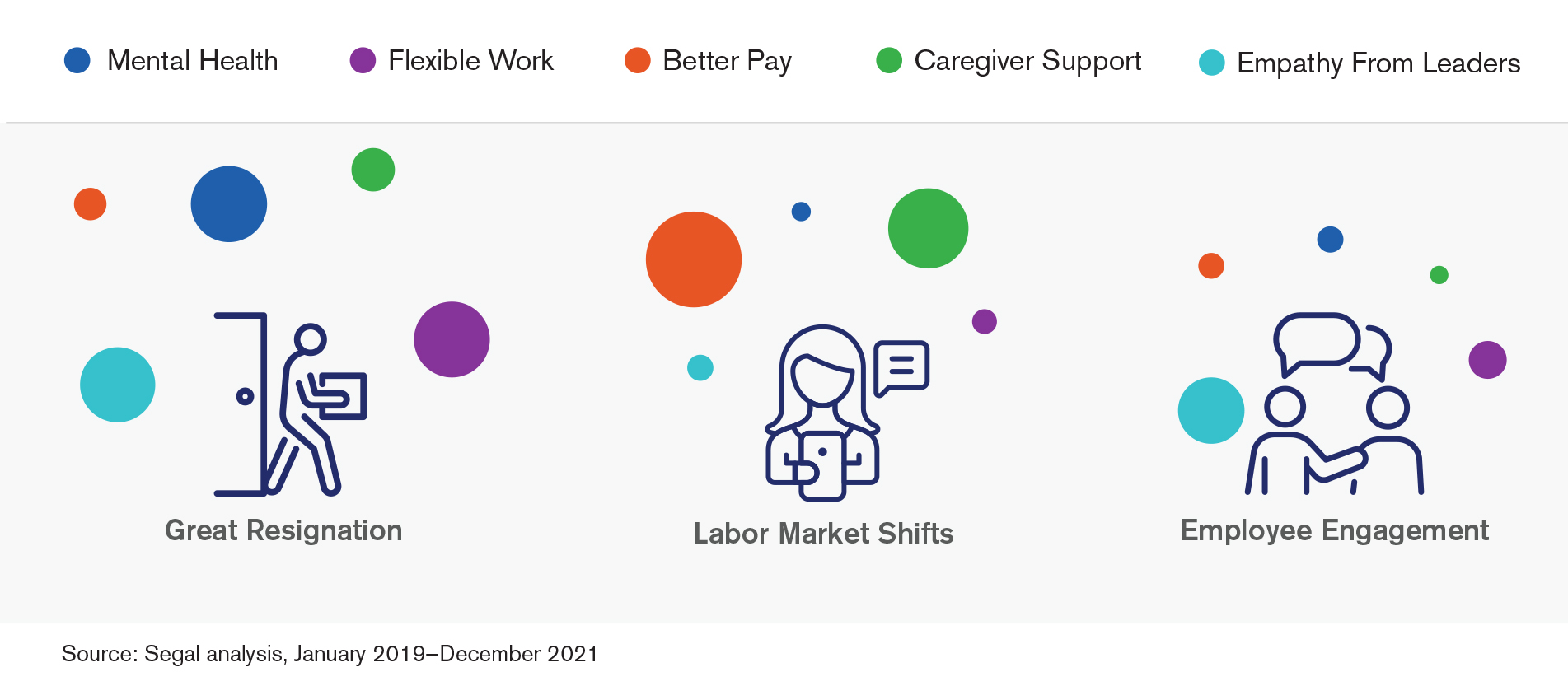

Archived Insight | February 8, 2022
The relationship between employers and their people has been tested in ways that could never have been imagined just a few short years ago. The pandemic turned the world upside-down and with it, what employees needed — and expected — from their employers and vice versa.
Employees were asked to work differently, demonstrate resilience and trust their leaders — while balancing the riptide of fear, illness, insecurity and caregiving responsibilities.
Organizations were asked to navigate hurricane-like uncharted business waters while prioritizing employee health, safety and dynamic employee expectations. Simultaneously, society at large experienced political, economic and social unrest, much of which seeped into the workplace.

Share this page
These seismic shifts have impacted the social contract between employers and their people, which defines what each expects from their relationship. Every employer will need to decide how this rapidly evolving social contract impacts their business and workforce. For employers in some industries, the impact may be minimal. In other sectors, however, employers may need to modernize their employee value proposition (EVP), total rewards or internal communications to remain competitive. Some organizations may need to face some hard truths about why they can’t get or keep talent.
Over the past two years, much of the conversation about the changing social contract has focused on wages, social protections and supports. Workers with skills in high demand are calling the shots. They’re asking potential employers for more of what is meaningful to them — namely, higher wages, more flexibility, childcare support, robust health and retirement programs and clearly defined career paths. They are also seeking jobs with empathetic leadership and an inclusive culture that creates a sense of belonging.
Many of these issues existed before 2020 and could signal a natural self-correction of labor norms. In some cases, the younger workforce generation is realigning the priority of work in their lives. However, the pandemic and tight labor market are the key catalysts of change.
Those who don’t find what they seek at work are choosing to look elsewhere. Consequently, the U.S. is experiencing significant labor shifts and shortages in some industries. According to the Bureau of Labor Statistics, November 2021 experienced historic worker turnover with a record 4.5 million people quitting and almost as many (4.3 million) leaving their jobs in December 2021. We recently discussed key questions employers should consider as they compete in the current labor market.
Origins and Evolution of the Employer-Employee Social Contract
The term “social contract” was originally conceived to describe a sociopolitical theory that people agree to give up certain individual freedoms either in exchange for the broader benefit of society or for something of value (e.g., security). Philosophers, such as Socrates, Jean-Jacques Rousseau, John Locke and Thomas Hobbes discussed this social contract.
This theory extended to the labor market where employees agree to work in exchange for wages paid by their employer. In most developed nations, the employer-employee social contract matured to include minimum wage rates, safety standards, paid and unpaid time off, anti-discrimination statutes and child-labor restrictions. The role of the labor union rose to prominence in many nations and with it, employer-sponsored pension and health insurance programs became prevalent.
As each new generation enters the labor market — and as technology continues to further weave itself into the fabric of human existence — the evolution of the employer-employee social contract has continued with some predictable cadence. Until now. The pandemic accelerated change in the employer-employee social contract.
Human resource departments are beginning to look and sound more like marketing professionals. They understand that to find and keep great people, among other things, the organization must crisply articulate its value proposition. This begins to define what the organization expects of its talent and vice versa — their respective social contract.
Company websites, recruiting materials, social media descriptions and leadership should have statements about the firm’s commitment to its people and describe:
In some industries, these assurances are table stakes. If that’s the case in your industry, you can’t afford to fall short.
Many factors are contributing to the changes in the employer-employee social contract. In a 2021 CEO poll, Segal and the Chief Executive Group found CEOs believe those factors include increased flexibility, meaningful two-way communications and modernizing where and how employees work.
In a separate analysis looking at data from January 2019 to December 2021, Segal identified mental health concerns, a desire for flexible working conditions, better pay, increased caregiver support and empathy from leaders as the top contributors to resignations and labor shifts. In addition, employee engagement, including creating a culture of safety, belonging and trust, grew in importance. The bubbles in the graphic below represent, by relative weight, these key topics in each category.
Key Factors Driving Change in the Employer-Employee Social Contract

As we move through 2022, we’ll continue to see meaningful shifts in the employer-employee social contract. As new generations enter the workforce, there will be greater emphasis on maximizing autonomy and flexibility, as well as reassessing work to balance personal and professional lives.
Throughout this year, we’ll explore the changing employer-employee social contract by diving deeper on the challenges and opportunities employers will face going forward. Specifically, we’ll look at this evolution through the lens of three central themes:
Join us on this journey. (If you’re not already on our mailing list, take a minute to sign up now.)

Technology, Benefits Administration, Communications, Multiemployer Plans, Public Sector, Healthcare Industry, Higher Education, Architecture Engineering & Construction, Consulting Innovation, Corporate, Benefits Technology, ATC, Organizational Effectiveness, Health, Retirement

Communications, Benefits Administration, Compensation & Careers, Consulting Innovation, Corporate, Benefits Technology, Retirement, Health, Investment

Technology, Organizational Effectiveness, Communications, Multiemployer Plans, Public Sector, Healthcare Industry, Higher Education, Architecture Engineering & Construction, Benefits Technology, Corporate, Consulting Innovation
This page is for informational purposes only and does not constitute legal, tax or investment advice. You are encouraged to discuss the issues raised here with your legal, tax and other advisors before determining how the issues apply to your specific situations.
© 2026 by The Segal Group, Inc.Terms & Conditions Privacy Policy Style Guide California Residents Sitemap Disclosure of Compensation Required Notices